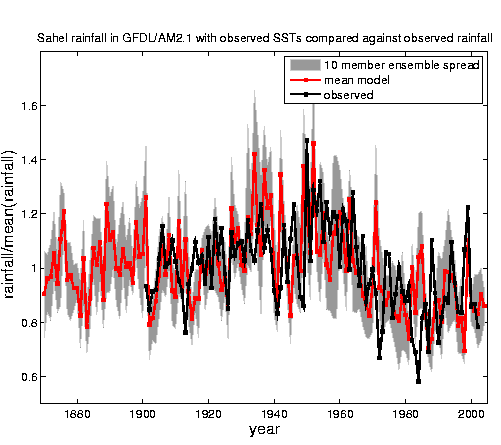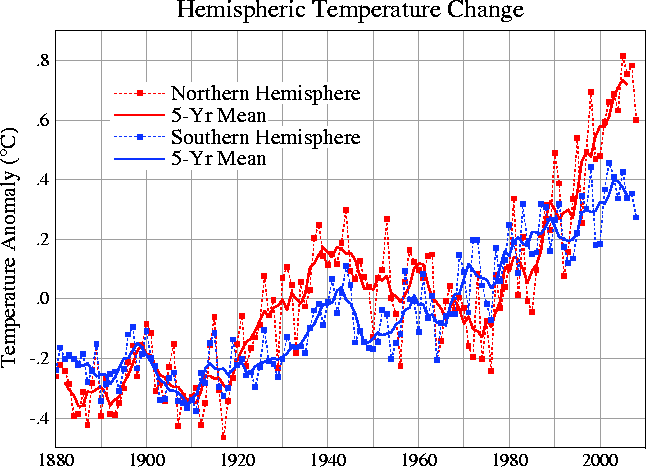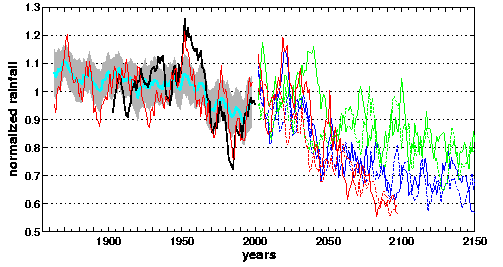Sahel Drought: Understanding the Past and Projecting into the Future
The Past:
The Sahel occupies a transitional zone between the Sahara to the north and tropical rain forests to the south. As for many such transitional zones adjacent to tropical rain belts, climate is highly variable due to the sharp gradients in rainfall. In the 1970’s and 1980’s, the region experienced a profound drought, with over a 30% decrease in rainfall over most of the Sahel as compared to the 1950’s– arguably the most dramatic drought in any region of this large an extent observed in the 20th century. In the figure below, the black line is the observed summer (July-Aug-September) rainfall averaged over the Sahel, normalized by its mean over the time interval shown, taken from the University of East Anglia’s Climate Research Unit (CRUTS2.1). A defense of the quality of the observational record after 1930 is provided by Dai, et. al.

Given this potential for large rainfall variations, and the economic, political, and social challenges facing the region, the possibility that increasing greenhouse gases could alter Sahelian rainfall is of great concern. Understanding the Sahel drought of the late 20th century and improving our future projections for the hydrological cycle in this region is a major challenge for climate dynamics and climate modeling.
It has been understood since the 1980’s (Folland, Palmer, and Parker) that changes in ocean temperature played a significant role in producing the late 20th century Sahel drought. For a more recent influential paper making a strong case for the dominance of oceanic forcing, see Giannini, Saravanan, and Chang. GFDL’s AM2.1/LM2 atmosphere/land model, developed in part for the IPCC’s 4th Assessment, produces the result shown above when provided with the observed ocean surface temperatures over the 20th century. This computation was repeated 10 times — the gray area is the full spread of these 10 simulations, while the red line is the mean. The impressive agreement extends to the beginning of the century, which is somewhat surprising given the uncertainties in the early decades of the 20th century in both the rainfall record and the ocean temperatures used as a boundary condition for these simulations. This result is described in Held, Delwortih, Lu, Findell, and Knutson. The observation that the rainfall reaches a maximum in mid-century, and that this maximum can be simulated, given the observed ocean surface temperatures, is evidence that the drying from the 1950’s to the 1980’s is unlikely to be primarily forced by increasing greenhouse gases in the atmosphere (assuming that these early century rainfall and ocean temperature records are robust).
A variety of modeling studies have pointed to changes in the inter-hemispheric temperature gradient, within the tropical oceans but also globally, as being of key importance for Sahel rainfall, with drought occurring when the Northern Hemisphere oceans are relatively cold as compared to the Southern Hemisphere oceans. During the early part of the 20th century, the Northern Hemisphere warmed more rapidly than the Southern Hemisphere, but from mid-century till 1980, the Northern Hemisphere cooled on average, while the Southern Hemisphere continued to warm. Since 1980, the Northern Hemisphere has once again warmed more rapidly. The result, as illustrated below by the temperature record (land plus ocean) as compiled by NASA’s Goddard Institute for Space Studies, the maximum warmth of the Southern relative to the Northern Hemisphere was achieved during the most severe period of the Sahel drought.

The picture that emerges seems to be relatively simple, even though the underlying dynamics may be quite complex: the tropical rain-belts are attracted to the relatively warm hemisphere, with the Sahel, which we can think of as the northernmost extension of these rain-belts in Northern summer, suffering drought when the Southern Hemisphere is relatively warm. This effect is thought to be relevant more generally throughout the tropics, and not just for Africa. See, for example, Chiang and Bitz on the interaction between the Ice Age ice sheets and tropical precipitation, and Yoshimori and Broccoli on the consequences for the tropical rain-belts of north-south asymmetry in radiative forcing. Sarah Kang (graduate student in Princeton’s AOS Program), has studied the underlying dynamics in a variety of idealized models (the first paper emerging from this work is Kang, Held, Frierson and Zhao).
An alternative hypothesis, popular during the 1970-1980’s drought itself, is modification of the land surface due to human activity, usually termed “desertification”. Climate models do suggest that one can reduce Sahel rainfall by increasing the surface albedo (the reflectivity of the surface to solar radiation), a result expected from the loss of vegetation, but models have not produced responses of adequate magnitude by this mechanism, and it is difficult to explain a mid-century maximum in rainfall through land alteration. See Brooks for further discussion of this major shift in perspective from one in which land alteration is directly responsible for the drought to one in which oceanic changes unrelated to any land modifications are deemed to be the dominant cause. The dominance of oceanic forcing in the past does not deny the possibility that major land modifications could be a factor in the future, or that the feedback of land vegetation to the changes in rainfall could be important for the observed variations.
If we accept that inter-hemispheric gradients in ocean temperature are a key proximal cause of multi-decadal Sahel rainfall variations, the search for the ultimate cause becomes the search for an explanation for these ocean temperature variations, A substantial part of these changes in temperature gradient is likely due to internal variability, the source of this variability most likely being in the meridional overturning circulation in the Atlantic Ocean. Zhang and Delworth, for example, have shown how manipulating the northward heat flux by the Atlantic ocean in a climate model can alter Sahel rainfall. But aerosol forcing has also been implicated as a potential candidate for the drying tendency since mid-century, with increasing sulphate pollution in the Northern Hemisphere causing the Northern Hemisphere to cool relative to the south. The recent warming in the north is, in this interpretation, caused by cleansing of the Northern Hemisphere atmosphere. Rotstayn and Lohmann have argued that the evolution of aerosol forcing is large enough to explain a large fraction of the Sahel drought, if one includes relatively large indirect aerosol effects associated with cloud/aerosol interactions. Biasutti and Giannini describe the results in the CMIP3 coupled-climate model simulations utilized by the IPCC’s 4th Assessment, and conclude that there is a small forced component to the drying trend over the 20th century in most of these models. This trend does not continue into the future in the multi-model average, implying that the dominant forcing in the models is not greenhouse gases but rather aerosols, in qualitative agreement with Rotstayn and Lohmann. Greater confidence in our ability to estimate past variations in aerosol forcing will be needed to make further progress on this aspect of the problem. But, once again, to the extent that the precipitation did indeed maximize in mid-century, the more plausible explanation for the bulk of the observed variability remains internal variability.
CM2.1 — an outlier in its prediction of the future of Sahel rainfall
Closer comparison of the changes in the inter-hemispheric ocean temperature gradient and Sahel rainfall suggests the possibility that another process has operated in recent years. The Northern Hemisphere has warmed quite rapidly since 1980, which one might expect to have led to a more pronounced amelioration of the drought. Indeed. Atlantic hurricanes, which are plausibly controlled by the same difference in temperatures (at least within the Atlantic Ocean) have recovered to an activity level more comparable to mid-century values.
Analysis of the AM2.1 atmospheric model, which generates the striking fit to observed Sahel rainfall variations shown above, when forced with observed surface ocean temperatures, shows that the model is not simply responding to changes in inter-hemispheric temperature gradients. The model also dries the Sahel when the oceans are warmed uniformly. Given this behavior, it is not surprising that when this model is coupled to an ocean in GFDL’s CM2 climate model, it predicts continued drying into the future; indeed, as indicated in the following figure, the drying it projects exceeds that experienced in the 1980’s by the mid-21st century.

In this figure, the black line is again the observations of summertime Sahel rainfall, but with a 5 year running filter. The red line prior to the year 2000 is a single realization of the freely running coupled model (unconstrained by observed ocean temperatures) but forced with estimates of the evolving greenhouse gas, aerosol, and volcanic forcing since 1860. One does not expect a particular freely running simulation of this type to simulate observations which depend in part on details of the natural variability in the oceans, but, given enough realizations, one does expect to find some that resemble observations. The realization chosen here is the one (out of 6) that most resembles the observed time series. The gray area shows the typical spread of the realizations (plus and minus one standard deviation), while the thick blue line is the mean of this ensemble. The mean provides an estimate of the forced part of the variation, which further analysis indicates is partly due to greenhouse gases in this simulation and partly to aerosol forcing. The three colors of lines continuing into the 21st century are the results of simulations of the future (using the B1(green), A1B(blue), and A2(red) SRES scenarios).
The average over the climate models utilized by the IPCC AR4 assessment is for little change in Sahel rainfall, with a number of models generating modest increases in rainfall, some generated modest drying, but no others producing the dramatic drying in CM2 One is tempted to reject this simulation as an outlier. Analysis supporting this position is provided by Cook and Vizy and Cook .
We are hopeful that we will find serious flaws in our model that would cause us to reject its projection as unrealistic. There are metrics based on comparison with a variety of observations that one can try to use to evaluate climate models. Ideally, there would be an model property A (for which there are observations to compare against) which takes on values in the world’s climate models that are correlated with, or, more generally, can be used to predict, the 21st century Sahel rainfall projections in this same set of models. The difference between a model’s A and the observed A then provides a metric that is demonstrably relevant to Sahel rainfall projection. There are several excellent examples of this approach in the literature, related to other aspects of climate projections, a particularly clean example being the study of snow albedo feedback by Hall and Qu . An informative but unsuccessful attempt to isolate such a metric from the co-variability of ocean temperatures and Sahel rainfall in the models is described by Biasutti, Held, Sobel, and Gianinni . In the absence of an ability to predict a model’s Sahel rainfall projection from a model’s behavior in the 20th century, we are left with subjective metrics that are not fully satisfying.
Plausible sources of this difference between AM2/LM2 and other models can be found in the land surface model and in the treatment of convection and clouds in the atmosphere. Our analysis indicates that it is the latter, convection and clouds, that are the most likely source of our model’s outlier status — specifically, we can change the atmospheric model’s response over the Sahel to a uniform warming of ocean temperatures by modifying the treatment of convection/clouds, but have not found comparable sensitivity to the land model. While we believe we can modify our model to generate much weaker drying in its Sahel projections, we have not yet been able to generate a model of this type that has a 20th century Sahel rainfall simulation of comparable quality.
Therefore, we are not yet ready to reject the hypothesis that, superposed on large multi-decadal internal climate variations, and on aerosol induced changes, there is also a suggestion of a greenhouse induced drying trend that will emerge clearly over the present century. More detailed information on internal variability in the Sahel over longer time scales is of vital importance, as is a much clearer understanding of why climate models differ even in the sign of the change expected in Sahel rainfall from increasing greenhouse gases.


